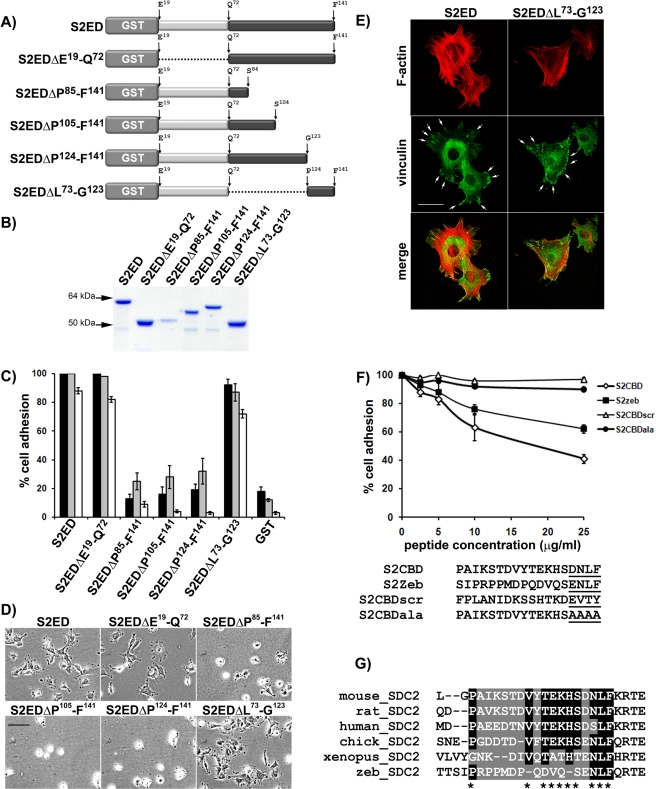FIGURE 1:
The adhesion regulatory properties of the syndecan-2 extracellular core protein reside between P124 and F141. Schematic diagram of the mutated forms of S2ED proteins (A) and the purified proteins resolved by SDS–PAGE and stained with Coomassie brilliant blue (B). (C) Wells were coated with each form of S2ED and seeded with either Swiss 3T3 (dark gray bars) or WI38 human lung fibroblasts (light gray bars) or primary murine lung fibroblasts (white bars) in serum-free media. Cell adhesion was measured after 60 min of incubation, and percentage adhesion was calculated relative to adhesion to S2ED, set at 100%. Error bars represent the SD of absorbance measurements made from four separate wells. (D) Phase-contrast micrographs of Swiss 3T3 fibroblasts seeded in serum-free media onto wells coated with each form of S2ED and captured after 60 min (scale bar, 50 μm). Only forms of S2ED that contain the 18–amino acid region of S2ED between Pro124 and Phe141 support fibroblast attachment and spreading (namely S2ED, S2EDΔE19-Q72, and S2EDΔL73-G123). (E) This adhesion regulatory region also stimulates focal adhesion formation in fibroblasts. Swiss 3T3 fibroblasts were seeded onto glass coverslips coated with either S2ED or S2EDΔL73-G123 as indicated, fixed, and stained for the focal adhesion component vinculin (green) and F-actin (red) after 60 min of incubation. Both substrates stimulate focal adhesion formation (denoted by arrows; scale bar, 50 μm). Fibroblast adhesion to S2ED is reduced in the presence of peptides corresponding to murine S2ED (P124–F141) and zebrafish S2ED (S130–F147). (F) Swiss 3T3 fibroblasts were seeded on wells coated with S2ED in the presence of peptides (sequences below graph) corresponding to murine syndecan-2 P124–F141 (S2CBD), a scrambled peptide based on this sequence (S2CBDscr), a peptide based on the murine syndecan-2 P124–F141 peptide in which the terminal four residues (D138–F141) are substituted with four alanine residues (S2CBDala), and a peptide corresponding to the equivalent region of zebrafish syndecan-2 at the concentrations indicated. Cell adhesion was measured after 60 min of incubation, and adhesion to S2ED in the absence of peptide was set at 100%. Error bars represent the SD of absorbance measurements made from six replicates. Both murine and zebrafish peptides inhibit cell adhesion to S2ED, whereas the scrambled control and the peptide in which the last four C-terminal residues have been substituted with alanine residues have no effect on cell adhesion. (G) Sequence alignments of the syndecan-2 adhesion regulatory domains (highlighted) from several vertebrates reveal few conserved amino acid residues between murine and zebrafish sequences, except for the adhesion regulatory C-terminal SD/ENLF motif.

